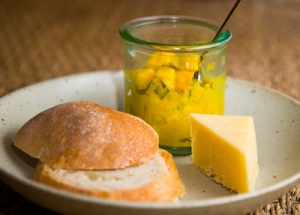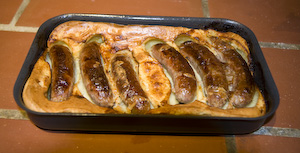You are currently browsing the category archive for the ‘English food’ category.
Most of the piccalilli recipes I’ve seen agree on one thing. It doesn’t much matter which vegetables you use as long as cauliflower is one of them. Often when recipes leave the choice of vegetables or herbs to the individual cook, it’s because various combinations will create different, but equally acceptable effects. In the case of piccalilli, it’s because, underneath all that mustard, it’s pretty much impossible to taste the separate vegetable flavours.
Normally when I cook, I consider appearance as important, but secondary to the flavour. In choosing piccalilli ingredients, as long as there’s some crunch in the bits, the appearance becomes more important than the flavour. I like to see some green, so I’ll use either cucumber or courgette as well as some green beans. Carrot adds a few bits of orange, then some neutral can come from parsnip or celeriac. Tiny silverskin onions would be nice, but I rarely manage to find any, and they’d be very fiddly to peel, so I’ve generally used pickling onions or shallots and cut them into four. Sometimes the bits stay together and sometimes they don’t. It doesn’t seem to make much difference.
It seems that various forms of “Indian Pickle” were becoming popular during the 18th century. Hannah Glasse didn’t have a recipe for it in the first edition of her book in 1747, but she added one to the fifth edition in 1755. Elizabeth Raffald’s version in The Experienced English Housekeeper, 1769 is more similar to modern ones, and includes cabbage, cauliflower, cucumber, “raddish pods”, kidney beans and beetroot or “any other thing you commonly pickle.”
 Sadly, piccalilli isn’t very fashionable these days, and when I mention it, there’s rarely any enthusiasm in the response. I have noticed, though, that if a jar is put on the table, it is usually empty by the end of the meal. It goes well with cold meat, pork pie, sausages, or in a cheese sandwich. Many of the more modern authors seem to have decided that adding sugar is a good idea. It isn’t. The recipe below is more or less based on the version given by Nick Sandler and Johnny Acton in their book, “Preserved,” (one of the few that doesn’t add half a pound of sugar).
Sadly, piccalilli isn’t very fashionable these days, and when I mention it, there’s rarely any enthusiasm in the response. I have noticed, though, that if a jar is put on the table, it is usually empty by the end of the meal. It goes well with cold meat, pork pie, sausages, or in a cheese sandwich. Many of the more modern authors seem to have decided that adding sugar is a good idea. It isn’t. The recipe below is more or less based on the version given by Nick Sandler and Johnny Acton in their book, “Preserved,” (one of the few that doesn’t add half a pound of sugar).
Ingredients
1 kg/good 2 lbs vegetables (including cauliflower plus others as you choose)
2 Tbsp salt
1 Tbsp turmeric
50g/2oz mustard powder (yes, really!)
½ tsp ground white pepper
50g/2oz plain flour
¼ tsp ground nutmeg
250 ml/8 fl oz cider vinegar
250ml/8 fl oz malt vinegar
Break the cauliflower into small florets and cut the remaining vegetables into small dice (about ¼”). Mix in the salt, cover the bowl, and leave them overnight.
Mix the spices, flour and 80ml/3 fl oz cider vinegar until it’s smooth. Slowly stir in the rest of the cider vinegar, pour it into a large saucepan, and add the vegetables and malt vinegar. Heat it gently until the sauce starts to simmer. Add a little water if the sauce seems too thick. If you want the vegetables to be soft, you can continue to cook it for a few minutes, but I like to remove it from the heat as soon as it reaches simmering.
Pour the piccalilli into sterilised jars. This quantity will make about three 300ml/12 oz jars.
Some of the recipes in Hannah Glasse’s The Art of Cookery, made Plain and Easy seem to come from another world. So much has changed in the 260 years since she was writing that the many of the recipes seem bizarre and most of us would have no idea how to combine them to produce a coherent meal. Some recipes use birds or fish that aren’t commonly eaten these days, or use bits of them that we’re not used to eating (there are three different ways to cook a cod’s head, for instance). Some have combinations of sweet and savoury that look strange these days: like sprinkling sugar over your potatoes.
It’s a surprise, in the midst of this alien world, to come across a recipe that is still in common use, pretty much unchanged.
To make Common Saufages.
Take three Pounds of nice Pork, Fat and Lean together, without Skin or Grifles; chop it as fine as poffible, feafon it with a Tea Spoonful of beaten Pepper, and two of Salt, fome Sage fhread fine, about three Tea Spoofuls; mix it well together, have the Guts very nicely cleaned, and fill them, or put them down in a Pot, so roll them of what Size you pleafe, and fry them. Beef makes very good Saufages.
For “fine sausages,” she recommends using only lean pork, and substituting beef suet for the fat (using equal quantities of pork and suet), and adding sweet herbs, nutmeg and lemon zest to the seasoning.
Of course, sausages are much older than the 18th century. They were certainly around in Roman times, though the fact that the latin name for sausages is the origin of the word “botulism” suggests it would have been wise to approach them with some caution.
It’s quite possible that even in Glasse’s day those who were less wealthy than her readers might have added some cereal to the mix. These days, some sausages, like Glasse’s, are made with just meat and seasonings, while others have substantial cereal additions. Walls sausages for instance contain about 65% meat, with water and rusk making up the bulk of the remainder.
I’ve experimented with various formulae, and finally decided that just a little bread improves the sausage texture and helps it to stay juicy when it’s cooked. I use pork shoulder, and try to get a moderately fatty piece. If there isn’t much fat, then I’ll add in some belly pork, or extra back fat (if you’re buying your meat from a butcher, he’ll probably have some he can spare). I also like a pretty traditional seasoning, but there’s plenty of scope for variation: rosemary and thyme; juniper; fennel…
For a couple of pounds of meat, I use:
1 1/2 oz breadcrumbs (about 5% of the weight of the meat)
1 Tbsp Maldon salt (the brand isn’t important, but the big flakes mean you don’t get so much in a tablespoon – if you’re using finely ground salt, use 2 tsp, or 1.5% of the weight of the meat)
Chopped sage – a handful
1/2 Tbsp ground mixed spice (about half black pepper, and the rest a mixture of nutmeg, mace, cinnamon, clove, allspice).
2 yards of hog casings (sheep casings give thinner, chipolata-size sausages)
Mince the meat. I prefer a coarse grind. Mix in the breadcrumbs and seasonings, then put the mixture through the mincer again. My mincer has an attachment for stuffing sausages. Basically, you remove the chopping plates, and add a funnel. Lubricate the outside of the funnel (butter or lard work pretty well). Thread the sausage casings onto the funnel, then feed the mixture through again, this time into the casing. Tie off the ends of the casing and twist the sausages to the length you want.
The sausages will be better if you can leave them for a day or two before cooking them. I put them on a plate in the fridge, covered with kitchen paper.
You could fry them and serve with mash and/or braised sauerkraut; braise them with beef stock, red wine and chestnuts; or combine them with another old English favourite, Yorkshire Pudding, to make Toad in the Hole.
I’m staying with the old English recipes this week. Today I started a batch of mushroom catsup, following Eliza Acton’s eloquent directions.
“One of the very best and most useful of store sauces is good home-made mushroom catsup, which, if really well prepared, imparts an agreeable flavour to any soup or sauce with which it is mingled, and at the same time heightens the colour without imparting the ‘bitter sweetness’ which the burnt sugar used as ‘browning’ in clumsy cookery so often does. The catsup ought, in fact, to be rather the pure essence of mushrooms, made with so much salt and spice only as are required to preserve it for a year or longer, than the compound of mushroom-juice, anchovies, shallots, allspice, and other condiments of which it is commonly composed, especially for sale.”
The word “catsup” isn’t much used in England these days, and the alternative version, “ketchup” is generally only used for the tomato flavoured condiment. Mushroom catsup is strongly flavoured and salty: more akin to soy sauce or Worcester sauce than to tomato ketchup. I looked it up in an online etymological dictionary:
ketchup
1711, from Malay kichap, from Chinese (Amoy dial.) koechiap “brine of fish.” Catsup (earlier catchup) is a failed attempt at Anglicization, still in use in U.S. Originally a fish sauce, early English recipes included among their ingredients mushrooms, walnuts, cucumbers, and oysters. Modern form of the sauce began to emerge when U.S. seamen added tomatoes.
I made some mushroom catsup a couple of years ago, and we’ve just used the last of it, so I picked up a couple of kilos of mushrooms from the farmers market this morning, and have just broken them into bits and salted them. Eliza Acton specifies 3/4 lb salt for 2 gallons of mushrooms. At that time, an English pint was 16 fl. oz, like the current American pint, not 20 fl. oz. like the British Imperial pint, so her 2 gallons is about 7 litres. My two kilos of mushrooms came a bit short of filling a 2 litre bucket, so I decided to stick with her quantities, and used 350g salt. The mushrooms will sit for three days, being stirred occasionally, then be simmered gently for fifteen to twenty minutes. The liquid is to be strained off without pressing , and boiled until it is reduced by half. Then, for every quart of liquid (about a litre) add ½oz (15g) black pepper, a drachm (5g) of mace (¼ tsp cayenne may be used instead of the black pepper). Store it in a cool place overnight, then pour it into bottles, leaving the sediment, and seal the bottles.
Apparently a second grade of catsup can be made by sqeezing the mushrooms, and mixing the squeezed juice with the sediment from the first batch. This second pressing should be more highly seasoned, using cloves, pepper, allspice and ginger.
I use the catsup for flavouring soups, stews and sauces – in the way you might use Worcester sauce, though it has a subtler flavour. It’s one of those things that sounds pretty recherché, but once you get used to having it around, you don’t like to do without it.
Update: 2 kg (4½ lb) of mushrooms produced about 1 litre (2 US pints) of liquid, which I boiled down to half a litre, so I added ¼ oz (7g) pepper and 3g mace. There was quite a lot of sediment, so I ended up with about 250 ml of catsup.
If you want to make a single 100 ml bottle of catsup, you’d need about 1 kg/2 lb mushrooms; 6 oz/170g salt; 2 tsp pepper and ½ tsp mace.

